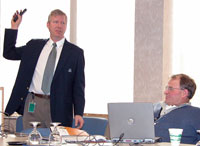 Nitrogen utilization is a very important issue today. Ask Cindy, who’s editing our DomesticFuel site where we have regular input from a guy who has a problem with the fact that so much nitrogen fertilizer is put on crops that are turned into fuel today (corn most importantly). Here’s Pioneer’s Paul Gaspar, Agronomy Research Scientist, giving us an update on what Pioneer is doing to improve nitrogen efficiency in corn.
Nitrogen utilization is a very important issue today. Ask Cindy, who’s editing our DomesticFuel site where we have regular input from a guy who has a problem with the fact that so much nitrogen fertilizer is put on crops that are turned into fuel today (corn most importantly). Here’s Pioneer’s Paul Gaspar, Agronomy Research Scientist, giving us an update on what Pioneer is doing to improve nitrogen efficiency in corn.
Non-NAFTA Countries Key to Expanding Canadian Pork Exports
 The Canadian Pork Council suggests, in the face of stable North American consumption, it’s important for the Canadian pork industry to continue its focus on sales opportunities in non-NAFTA countries.
The Canadian Pork Council suggests, in the face of stable North American consumption, it’s important for the Canadian pork industry to continue its focus on sales opportunities in non-NAFTA countries.
Last year Canadian pork set new records in terms of both the volume and value of its exports.
While exports to the United States, Canada’s largest export market, declined sales to other key markets, most notably Japan and South Korea increased dramatically.
Canadian Pork Council President Clare Schlegel suggests, with demand in Canada and the U.S. holding stable, we’ll definitely need to see sales continue to rise in countries beyond North America.
“Support is vital. We need a successful WTO round from a Canadian perspective,” said Schlegel in a recent interview. “Market access is absolutely critical and the lowering of tariffs into some of these countries. We know that some of our competitors are working very diligently on free trade agreements, bilateral agreements between two countries.”
He said one example is where both the United States and Chile would get preferential access over Canadian product, a definite problem for Canada. Thirdly, the industry needs continued support from the Canadian government, especially from the embassies abroad, and trade promotion programs.
We need to increase the desirability and presence of the Canadian image, particularly in markets around the world where we’re selling through to retail.
“There are exciting possibilities, particularly in Korea and maybe even in Mexico where we can increase our sales opportunity by increasing the Canadian brand and the Canadian presence,” said Schlegel. Last year’s strong performance is a clear indication we’re putting out a desirable, consistent, and tasty product. I congratulate the industry on its achievements.
Communicating Agronomy Research Information
 Number two on the program today is Steve Paszkiewicz, Agronomy Research Scientist.
Number two on the program today is Steve Paszkiewicz, Agronomy Research Scientist.
Here’s Steve showing us a slide with all the agronomists that work for Pioneer around the U. S.
At the start of his presentation he discussed ways Pioneer is working to communicate information to growers like their Field Facts newsletter that is available on their GrowingPoints website. I interviewed Steve on the break and will add the interview as soon as I can.
POST ADDITION:
Here’s my interview with Steve. Steve says they take a multimedia approach to delivering agronomy research information that includes an internal internet system for the company and it’s representatives, printed materials that are mailed out and their GrowingPoint website which is available to their grower customers. He says it’s been interesting to see the continuing growth in grower use of the website and how they use different parts of the site depending on the season of the year.
You can hear my interview with Steve here:  Steve Paszkiewicz Interview (6:12 MP3 File)
Steve Paszkiewicz Interview (6:12 MP3 File)
M-Series Is Driving Yield Enhancements
 We’re back in the presentation room here at Pioneer. Today is research day. Lots of information about the research work that’s going on.
We’re back in the presentation room here at Pioneer. Today is research day. Lots of information about the research work that’s going on.
To get us started, Paul Stephens, Senior Research Scientist, talked about the M-Series soybean program. Probably most of you have seen one of their advertisements with the green soybean plant flexing its muscle. It’s all about improving yields.
Right now Paul is doing Q & A. He was just asked about the idea of a consistent 100 bushel/acre yield. He thinks that’s about 10 to 15 years away since he’s currently hearing about consistent 70+ bushel/acre yields.
Siemens Says It On CJOB
 Yesterday Harry sent in a segment from a talk radio show he frequently appears on. I thought you might enjoy it.
Yesterday Harry sent in a segment from a talk radio show he frequently appears on. I thought you might enjoy it.
The regulations proposed by the Province of Manitoba government to deal with agriculture’s impact on water quality are unscientific, unenforceable, and will only put many small family farms out of business. Farm Journalist Harry Siemens debates the issue with Larry Updike, the Morning Man on News Talk CJOB Radio in Winnipeg, Manitoba.
You can listen here:  Harry On CJOB (2:40 MP3 File)
Harry On CJOB (2:40 MP3 File)
Dealing With International Biotech Regs
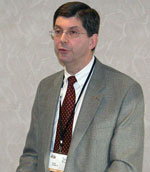 Our final presentation of today here at the Pioneer event is being given by Thomas West, VP, Biotech Affairs & Business Support. It’s Thomas’ job to work on biotech regulatory acceptance around the world. I’m assuming this means he’s got some serious frequent flyer miles.
Our final presentation of today here at the Pioneer event is being given by Thomas West, VP, Biotech Affairs & Business Support. It’s Thomas’ job to work on biotech regulatory acceptance around the world. I’m assuming this means he’s got some serious frequent flyer miles.
Right now he’s summarizing the situation in different areas of the world like China, India and the EU. There’s obviously a lot of regulatory action taking place in various countries.
I’m going to interview Thomas after he’s done and I’ll update this post then.
POST ADDITION:
You can listen to my interview with Thomas here:  Thomas West Interview (4:06 MP3 File)
Thomas West Interview (4:06 MP3 File)
Hearing About Pioneer Research From Hawaii
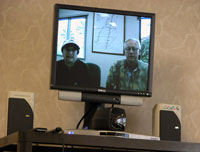 After a short break this afternoon we got our virtual tour of the Pioneer Hawaii Research Station. Our presenters are Steven Lupkes, Coordinator and Cindy Goldstein, Outreach Manager. They are “online” with us on a two-way video/audio hookup. They’re talking about how and why they do research in Hawaii and the benefits and challenges it represents.
After a short break this afternoon we got our virtual tour of the Pioneer Hawaii Research Station. Our presenters are Steven Lupkes, Coordinator and Cindy Goldstein, Outreach Manager. They are “online” with us on a two-way video/audio hookup. They’re talking about how and why they do research in Hawaii and the benefits and challenges it represents.
I recorded the first part of their presentation. This audio cut starts out with Cindy talking. Then there’s a few questions and answers. The questions didn’t record very well but you can hear Steve and Cindy very well. You can listen here:  Virtual Hawaii Research Station (9:04 MP3 File)
Virtual Hawaii Research Station (9:04 MP3 File)
Sit Down And Chill Out
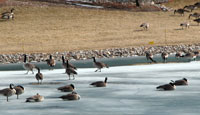 Right behind the Pioneer Carver Center is a very pretty little pond which is totally frozen at the moment. I could see the geese through the window of the presentation room we’re in and had to take a quick shot of them before it gets too late.
Right behind the Pioneer Carver Center is a very pretty little pond which is totally frozen at the moment. I could see the geese through the window of the presentation room we’re in and had to take a quick shot of them before it gets too late.
They look pretty healthy. I’m betting that some pretty good quality corn is grown around here and these birds are well fed on the leftovers.
The warmest coat I’ve ever had was filled with goose down. It’s got to be pretty good protection or even these birds couldn’t sit on the ice in comfort.
How Pioneer Is Building A Better Bt
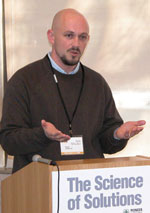 Presentation number two here at Pioneer is a tag team with Kyle Whitaker, Marketing Manager, who just got finished (pictured here) and Murt McLeod, Agronomy Research Scientist.
Presentation number two here at Pioneer is a tag team with Kyle Whitaker, Marketing Manager, who just got finished (pictured here) and Murt McLeod, Agronomy Research Scientist.
These guys are talking about “Building a Better Bt” and specifically Herculex.
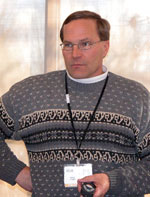 Murt’s taking now and he’s focusing on Herculex RW Research and describing the experimental design testing they’ve conducted. I’m recording the presentation and will decide later if it’s something to post. I will also try to get interviews with both these guys if time permits and post them later.
Murt’s taking now and he’s focusing on Herculex RW Research and describing the experimental design testing they’ve conducted. I’m recording the presentation and will decide later if it’s something to post. I will also try to get interviews with both these guys if time permits and post them later.
POST ADDITION:
After Kyle and Murt’s presentation I interviewed Kyle and he talks about the type of research that’s led to the new Bt products developed by Pioneer. He describes availability for the coming growing season and where growers can get more information.
You can listen to my interview with Kyle here:  Kyle Whitaker Interview (4:52 MP3 File)
Kyle Whitaker Interview (4:52 MP3 File)
Media Using Computers
 Since this is a “media” event then there’s got to be some media. Well here we are (I’m behind the camera). It’s a pretty good group of web/broadcast/print media representatives. I think it’s interesting that you can hear 6 different computers clicking away!
Since this is a “media” event then there’s got to be some media. Well here we are (I’m behind the camera). It’s a pretty good group of web/broadcast/print media representatives. I think it’s interesting that you can hear 6 different computers clicking away!
I wonder how many of us are “blogging” it.
